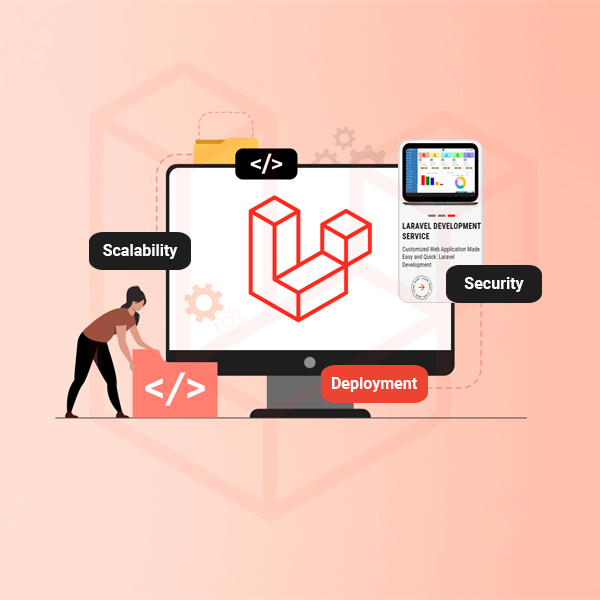How To Build Scalable And Secure Web Applications With Laravel
Overall, whether you are a start-up or an established organisation, scalability and security are unquestionably important for any web project.
Building scalable and secure web applications with Laravel involves a combination of architectural decisions, coding practices and deployment strategies. Laravel is a popular PHP framework that provides tools and features to help you create robust and maintainable applications. Here's a guide on how to achieve scalability and security using Laravel:
Project Setup:
- Use the Latest Version: Always use the latest stable version of Laravel to benefit from the latest features, bug fixes and security enhancements.
- Composer: Utilize Composer, the PHP dependency management tool, to manage your project's packages and dependencies.
Scalability:
- Database Optimization: Use Laravel's built-in ORM (Eloquent) to interact with the database. Optimize database queries, use indexes and cache frequently accessed data to reduce database load.
- Caching: Implement caching mechanisms using Laravel's caching features (Redis, Memcached, or file-based caching) to reduce the load on the database and improve response times.
- Queue System: Utilize Laravel's built-in queue system (using a queuing driver like Redis) to offload time-consuming tasks from the application and improve responsiveness.
- Load Balancing: Deploy your application across multiple servers and use a load balancer to distribute incoming traffic, improving performance and handling increased load.
- Horizontal Scaling: Consider a microservices architecture where different components of your application can be deployed and scaled independently.
Security:
- Use HTTPS: Always enable HTTPS on your application to ensure data transmission is encrypted. Use an SSL certificate to achieve this.
- Input Validation: Validate and sanitize user inputs to prevent SQL injection, XSS attacks and other security vulnerabilities.
- Authentication and Authorization: Implement Laravel's built-in authentication and authorization mechanisms. Use middleware to control access to routes and resources based on user roles and permissions.
- Password Hashing: Store user passwords securely by using Laravel's built-in hashing mechanisms. Never store plain-text passwords.
- CSRF Protection: Laravel provides built-in CSRF protection. Make sure it's enabled to prevent cross-site request forgery attacks.
- SQL Injection Prevention: Use parameterized queries or Eloquent ORM to prevent SQL injection attacks.
- Content Security Policy (CSP): Implement CSP headers to mitigate risks associated with cross-site scripting (XSS) attacks by controlling which sources of content are allowed to be loaded.
- Secure Configuration: Keep sensitive configuration information (such as API keys, database credentials) outside of version control and use environment variables or Laravel's configuration files.
- Regular Updates: Keep Laravel and its dependencies up to date to benefit from security patches and updates.
Performance:
- Leverage Caching: Use caching mechanisms to store frequently used data and improve response times.
- Optimize Images: Compress and resize images to reduce page load times.
- Minify Assets: Minify and combine CSS and JavaScript assets to reduce the number of requests and improve load times.
- Use Queues: Offload time-consuming tasks to queues to improve application responsiveness.
- Database Indexing: Properly index database tables to improve query performance.
Deployment:
- Environment Configuration: Set up different environment configurations (development, production, staging) to ensure that sensitive information is handled securely in each environment.
- Automated Testing: Implement automated testing using Laravel's testing tools to catch and fix issues before deployment.
- Continuous Integration/Continuous Deployment (CI/CD): Utilize CI/CD pipelines to automate the deployment process, ensuring that code is thoroughly tested and deployed consistently.
- Server Configuration: Follow best practices for server configuration, such as using secure SSH keys, configuring firewalls and regular server maintenance.
- Monitoring and Logging: Implement monitoring tools to track application performance, errors and security incidents. Laravel supports various logging drivers.
By following these guidelines, you can build scalable and secure web applications using Laravel. Remember that security is an ongoing process, so stay updated with the latest security practices and regularly audit your application for vulnerabilities.
TAGS: How To Build Scalable And Secure Web Applications With Laravel, Looking for Laravel Dev Team, Laravel Development Team, Hire Laravel Developer, Hire Laravel Developers in India, SaaS Application Development Company, Static website development cost in USA
